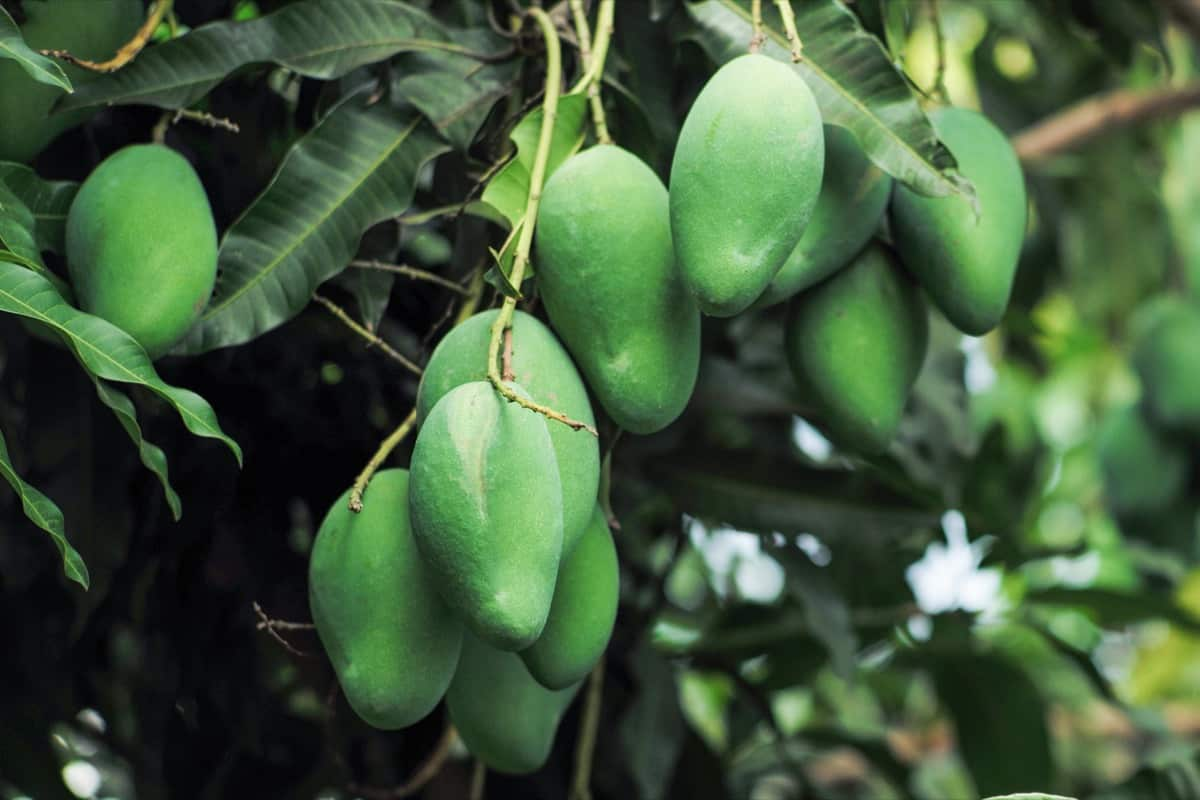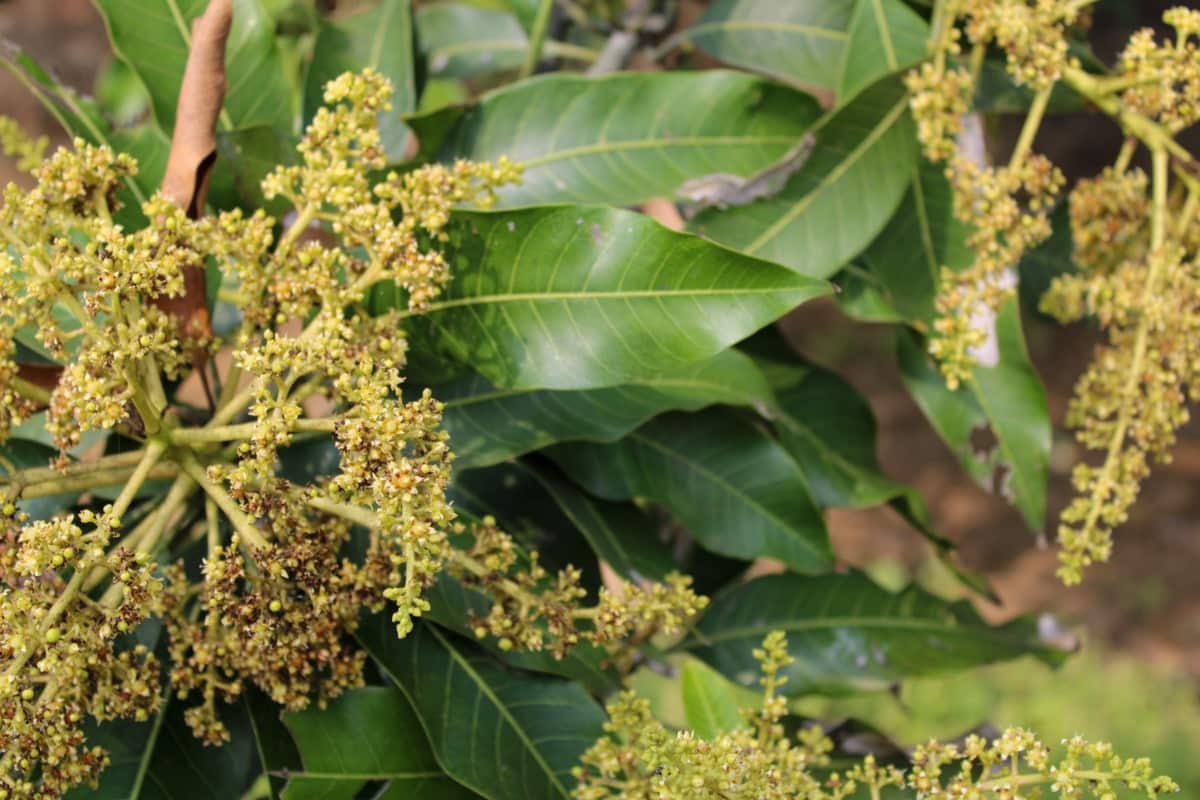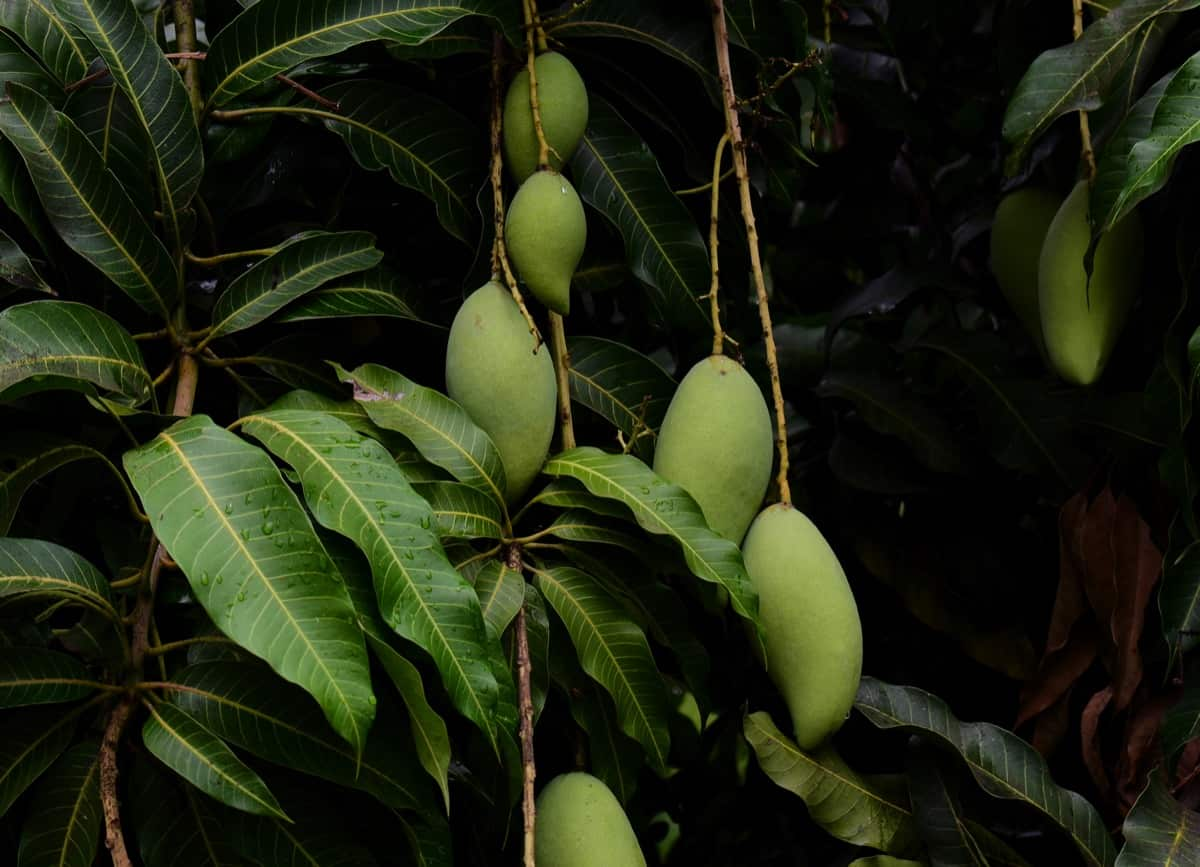Welcome, fellow mango enthusiasts! There’s nothing quite as delightful as sinking your teeth into a juicy, ripe mango. However, maintaining healthy mango trees can be challenging, especially with various pests that wreak havoc on these tropical beauties.

This blog post will explore the ten most common pests that threaten mango trees, including fruit flies, leafhoppers, thrips, mango leaf webbers, mealybugs, midges, shoot borers, stem borers, stone weevils, and pulp weevils, including their symptoms, identification methods, treatment options, and effective control and management strategies. Let’s check out the 10 common mango tree damaging pests below.
What is Mango Farming and Overview?
Mango trees are evergreen and produce edible fruit. It is native to India and Burma region and grown worldwide, including Kenya. Mango trees may reach 45 meters and survive over 100 years. The fruit is irregularly oval. Soft yellow-orange flesh. Yellow-green to crimson skin. Mangoes provide vitamins A, C, and D. Low in calories and fat.
Mangoes can be juiced, chutneyed, or cooked. Mangoes have varied flavors and textures. Mangoes need full light and loamy, well-drained soil. Monitoring mango trees for pests and diseases is crucial. Mango trees enhance home gardens. They are easy to grow and produce exquisite fruit for years.
10 Common Mango Tree Damaging Pests
Fruit Fly Damage on Mango Tree
Identification
- Fruit fly species include Ceratitis cosyra, Bactrocera obliqua, Bactrocera frauenfeldi, and Anastrepha spp.
- Adult fruit flies are small insects with colorful bodies and distinctive wings.
- Fruit fly maggots are white, legless larvae found inside infested fruits.
- The damage caused by fruit fly infestation leads to fruit flesh browning and softening.
Symptoms
- Adult female fruit flies lay eggs just under the skin of semi-ripe fruits.
- Maggots develop and feed inside the fruit, making the flesh turn brown and soft and emitting a foul smell.
- Infested fruits serve as entry sites for fungal and bacterial pathogens.
- Mature larvae come from the fruits and pupate in the soil, completing their life cycle.
Treatment and Control
- Fruit Collection: Collect and destroy fallen fruits to prevent the maggots from pupating.
- Early Harvest: Harvest fruits early to minimize damage caused by fruit fly infestation.
- Traps: Use traps to monitor and control fruit flies. Prepare traps by drilling holes in a plastic container and adding apple cider vinegar and a drop of unscented liquid dishwashing soap. Hang the traps near fruit trees before fruits ripen and check them frequently. Change the vinegar weekly.
- Protein Bait: Spray protein bait under leaf surfaces to attract fruit flies to a specific location, making it easier to kill them.
- Insecticides: If infestation is severe, use suitable insecticides as directed to control fruit flies.
Leafhoppers Damage on Mango Tree
Identification
- Major pests of mango, but only 3-4 species are serious pests.
- Species distribution varies, with some species restricted to the Indian subcontinent and others found in multiple Asian countries.
- Leafhoppers have a wedge-shaped body, broad head, and narrow abdomen. Species differ in coloration and size.
Symptoms
- Adults lay eggs on flowering shoots, flower buds, or tender leaves.
- Eggs hatch in 4-7 days, and nymphs go through 3-4 instars in 8-13 days.
- Leafhoppers congregate on panicles and tender shoots, sucking sap and causing withering and dropping of florets.
- Honeydew excreted by leafhoppers attracts sooty mold and affects photosynthetic efficiency.
- Severe infestations result in shining leaves and fruits covered in honeydew.
Treatment and Control
- Tree Management: Avoid dense planting and maintain proper tree architecture for adequate light penetration.
- Pruning: Regulate the number of flushes per year through pruning and reduced inputs.
- Botanical Pesticides: Use azadirachtin 1%, lemongrass oil (0.125%), or citronella oil (0.25%) for low hopper populations.
- Chemical Sprays: If hopper density exceeds four hoppers per panicle, use imidacloprid 17.8 SL, thiamethoxam, or lambda-cyhalothrin at appropriate concentrations during the panicle initiation stage. Avoid spraying during full bloom to protect pollinators.
- Conservation of Natural Enemies: Protect natural predators like coccinellids (ladybugs) and spiders by avoiding broad-spectrum insecticides and using entomopathogens like Metarhizium anisopliae and botanicals.
Thrips Insect Damage on Mango Tree
Identification
- Thrips are emerging sucking pests that infest mango leaves, flowers, and fruits.
- Different species feed on leaves or inflorescences.
Symptoms
- Thrips lay eggs in leaf tissue, with about 200 eggs per female.
- Larvae feed in groups, mainly on leaf midribs and veins.
- Adults are pale yellow or whitish with dark setae on the body and slender fringed wings.
- Thrips suck sap from leaves, inflorescences, fruits, and new flushes.
- Damage includes weakened inflorescences, reduced fruit set, bronzing of fruit surface, brown and curled leaf tips, and air-filled cavities in mature fruits.
Treatment and Control
- Monitoring: Use sticky traps to monitor thrips infestation regularly.
- Neem-based Products: Apply neem soap or neem-based pesticides at appropriate concentrations (e.g., ten g/l) to prevent thrips establishment.
- Conservation of Natural Enemies: Encourage predatory thrips, predatory mites (Amblyseius spp.), anthocorid bugs (Orius spp.), ground beetles, lacewings, hoverflies, and spiders to control thrips populations.
- Chemical Sprays: If infestation is severe, consider spraying imidacloprid, spinosad, or thiamethoxam at recommended concentrations.
Mango Leaf Webbers Pest Damage on Mango Tree
Identification & Symptoms
- Adult moths are medium-sized and lay dull greenish eggs on leaves.
- Larvae feed on leaf chlorophyll and web the leaves together, feeding on the entire leaf except for the midrib and veins.
- Fully grown caterpillars are brownish-blue with whitish striations.
- They undergo five instars, and the larval period ranges from 15 to 33 days.
- The mango leaf webber is a serious pest in Uttar Pradesh, Bihar, and North India.
- Caterpillars pupate within the web or descend onto the ground for pupation in the soil.
- Severely affected trees exhibit dry and brown webbed clusters of leaves, giving a sickly appearance.
In case you missed it: Mango Spongy Tissue and Black Tip Disorders Management: Symptoms, Causes, Favorable Conditions, and Treatment

Treatment and Control
- Pruning: Remove affected shoots and burn the leaf webs.
- Plowing: Expose pupae to natural enemies and sunlight by plowing the orchard.
- Insecticide Sprays: Use contact insecticides like quinalphos or lambda-cyhalothrin, applied at recommended concentrations, to effectively control leaf webber infestation.
Mealybugs Pest Damage on Mango Tree
Identification & Symptoms
- Nymphs hatch in winter, with a single female laying 400-500 eggs.
- Late instar nymphs and adult female mealybugs are flat, oval, and waxy white, adhering to panicles and shoots.
- Infested panicles shrivel, dry, and drop prematurely.
- Plants become covered in sooty mold.
- Infestation by giant mealybugs leads to significant size and weight loss of fresh mangoes, causing yield losses of up to 80%.
- The presence of white cottony cushioned nymphs and adults is a conspicuous symptom.
Treatment and Control
- Plow the orchard in November-December.
- Apply alkathene banding (25 cm wide, 30 cm above ground level) around the tree trunk, treated with Beauveria bassiana or NSKE in the second week of December.
- Release Cryptolaemus montrouzieri beetles (10 beetles/plant) for R. iceryoides control.
- Mix chlorpyrifos dust (1.5%) with soil around the tree trunk during the second week of December.
- If nymphs ascend the tree, spray carbosulfan (0.05%) or dimethoate (0.06%).
- Remove weed plants like Clerodendrum infortunatum, an alternate host of giant mealybugs.
- Natural enemies, including coccinellids, spiders, mites, and parasitoids, can prey upon mealybug nymphs.
Midges Pest Damage on Mango Tree
Identification & Symptoms
- Eggs hatch within 2-3 days, and maggots feed on tender parts, leading to drying and dropping of floral parts.
- Larvae pupate in the soil after destroying the inflorescence.
- Galled leaves fall early, affecting fruit development and yield.
- Heavily-infested trees have reduced inflorescence and low fruit yields.
- Mango midges (Diptera: Cecidomyiidae) are significant pests worldwide gall midges attacking mango in Asia.
- Midges lay eggs on floral parts, inflorescence axis, or tender leaves, causing damage at different stages of growth.
Treatment and Control
- Deep plowing in November exposes pupae and larvae to sunlight and natural enemies.
- Monitor larval population and dust chlorpyrifos (1.5%) on soil below tree canopy in April-May.
- Spray dimethoate (0.06%) at the bud burst stage.
- To control cecidomyiid pests, consume parasitoids like Platygaster sp., Systasis sp., Euplemus sp., and Tetrastichus sp.
- Predators like Formicidae can also control midge populations.
Mango Shoot Borers Damage on Mango Tree
Identification & Symptoms
- Several species of borers infest mango shoots. C. transversa is the most widespread and damaging borer, affecting litchi leaves.
- Eggs are laid on tender shoots or flower panicles, and the caterpillars bore into the midribs and then tunnel downwards into the shoots.
- Caterpillars mature in 10-12 days, leave the tunnel, and pupate in the tree bark or soil.
- Shoot wilting, drying, and excreta at entry holes indicate infestation.
Treatment and Control
- Remove and destroy infested shoots.
- Apply quinalphos (2 ml/l) or profenophos (1.5 ml/l) and neem oil (5 ml/l) twice at fortnightly intervals from the emergence of a new flush.
Mango Stem Borers Damage on Mango Tree
Identification & Symptoms
- Stem borers of the genus Batocera are serious pests of mango, including species like Batocera rufomaculata, B. rubus, B. roylei, B. numitor, and B. titana.
- B. rufomaculata is the most destructive and commonly found borer in mango orchards.
- They also attack fig, jackfruit, mulberry, papaya, apple, etc.
- Adult beetles emerge with the monsoon and lay eggs on the main trunk.
- Larvae tunnel through the sapwood, causing damage to sap flow, foliage, and production.
- Oozing of sticky fluid, frass, yellowing, drying, and dieback of branches are signs of infestation.
Treatment and Control
- Prune affected branches.
- Wrap stems with nylon mesh during May-August to capture emerging adult beetles.
- Apply a specialized formulation called ‘sealer cum healer’ on the stem with an insecticide and a fungicide to prevent egg laying.
- Remove and kill grubs from infected trunk holes.
- Plug holes with cotton soaked in insecticide to kill larvae inside the stem.
- Spray the trunk weekly with chlorpyrifos, imidacloprid, or thiamethoxam after the monsoon onset to prevent infestation.
Stone Weevil Damage on Mango Tree
Identification & Symptoms
- Eggs laid singly in depressions on the fruit surface.
- Grubs enter the nut or stone and feed on the outer coat in a zig-zag fashion.
- Larvae burrow through the pulp, destroying the stone and leaving a black mass.
- Damaged stones lose viability, making fruits unsuitable for consumption and processing.
- Infestation can range from 50% to 70% in susceptible mango varieties.
In case you missed it: Mango Alternate Bearing and Clustering Disorders Management: Symptoms, Causes, Favorable Conditions, and Treatment

Treatment and Control
- Collection and destruction of fallen fruits.
- Cleaning stem and branch junctions to disturb resting weevils.
- Spraying with deltamethrin at one ml/l when fruits are marble-sized.
- Directing insecticide sprays to the trunk during the off-season to kill adult weevils.
Mango Pulp Weevil Damage on Mango Tree
- Attacks fruit pulp, not the nut or stone.
- Occurrence is reported in Assam, Manipur, Meghalaya, Tripura, and West Bengal.
- Eggs are laid on the fruit surface, and larvae tunnel through the pulp to the kernel.
- Pupation occurs inside the fruit, and weevils emerge through a hole in the peel.
Fruit Borers Damage on Mango
- Red-banded caterpillar (Deanolis albizonalis) is the major borer pest of mango fruits.
- Occurrence in West Bengal and the east coast of Andhra Pradesh.
- Larvae bore holes in the apex or narrow tip of the fruit, tunnel through the flesh, and feed on the seed.
- Infestation leads to fruit spoilage and premature fruit drop.
- Collection and destruction of affected and fallen fruits are recommended for management.
Conclusion
Ten common pests that damage mango trees include fruit flies, leafhoppers, thrips, mango leaf webbers, mealybugs, midges, shoot borers, stem borers, stone weevils, and pulp weevils. These pests cause various symptoms, such as fruit browning, leaf withering, and premature drop. Control measures include fruit collection, traps, insecticides, pruning, and the conservation of natural enemies.
- Beneficial Insects in Pest Management
- Natural Solutions for Pest Control in Flower Gardens
- Types of Fungicides Used in Agriculture
- Common Issues in the Fruit Development Stage of Pomegranate Farming
- Fruit Development Issues in Papaya: Easy Solutions and Treatment
- Soil-Borne Diseases and How to Protect Your Plants
- Practices to Prevent Disease Spread in the Garden
- From Wilted to Thriving: How to Treat Root Rot Naturally in Houseplants
- Natural Remedies to Cure Brown Spots on Fig Tree Leaves